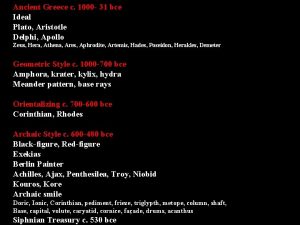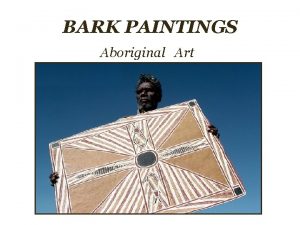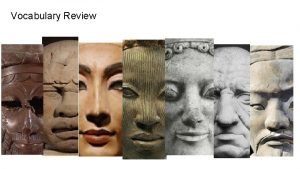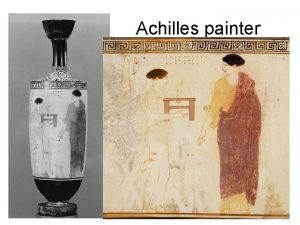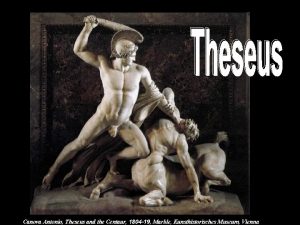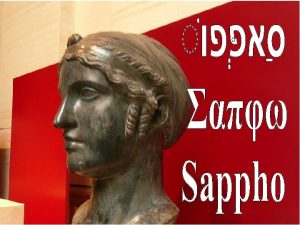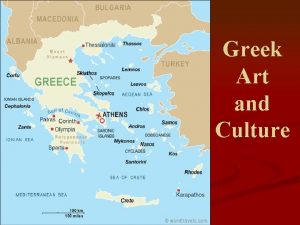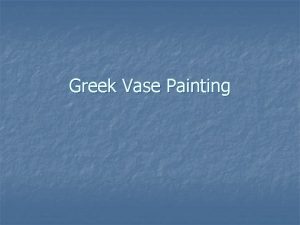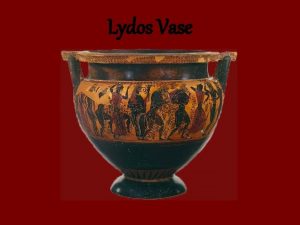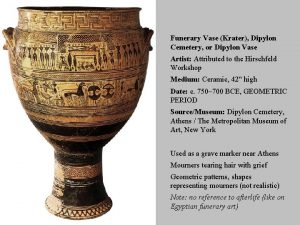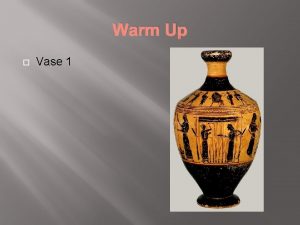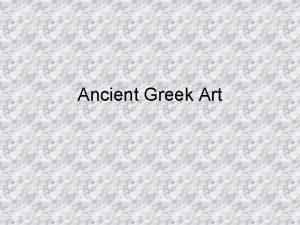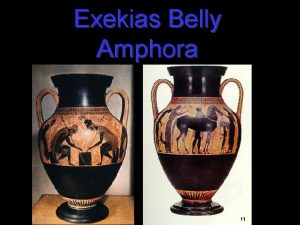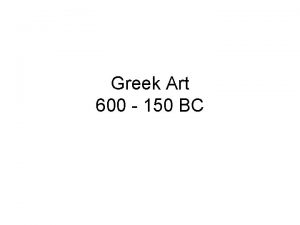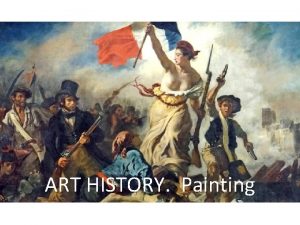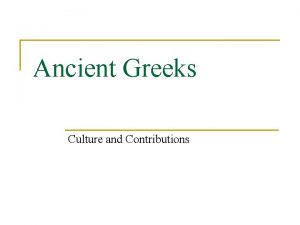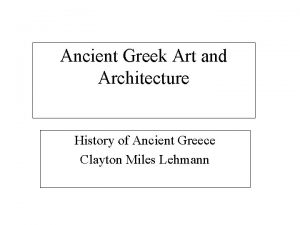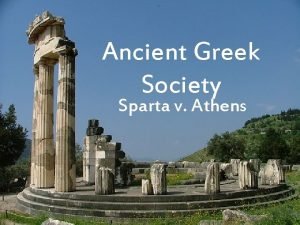Greek Vase Painting Ancient Greek Culture and Art

























- Slides: 25

Greek Vase Painting Ancient Greek Culture and Art (Click On One of the Blue Boxes to Begin)

Ancient Greek Art n n Most of the ancient Greek art that is still around today is in the forms of pottery, sculpture and architecture. Most ancient Greek paintings have deteriorated or been destroyed, except for most paintings on pottery. q Why are they gone? n n n Greek painters worked mainly on wooden panels, which deteriorated over time. One of the sad facts of ancient history is that when marble is burned, lime is produced, and that was also the fate of the great bulk of Greek marble statuary during the Middle Ages. Likewise, the shortage of metal during the Middle Ages led to the majority of Greek bronze statues being melted down. Those statues which had survived did so primarily because they had been buried and forgotten, or as in the case of bronzes having been lost at sea. The great majority of Greek buildings have not survived to this day: either they had been pillaged in war, had been looted for building materials or had been destroyed in Greece’s many earthquakes. Only a handful of temples, such as the Parthenon and the Temple of Hephaestus in Athens, have been spared.

Performing a libation, interior of a bowl by Makron, circa 480 BC. Paris: Louvre Procession of men, kylix by the Triptolemos Painter, circa 480 BC. Paris: Louvre Ancient Greek Pottery n n Greek pots are important because they tell us so much about how life was in ancient Greece. Ancient Greek pots were often beautifully decorated with scenes from daily life. Sometimes these scenes reflected what the pot was used for.

Shapes and Sizes Psykteres were wine coolers. Oinochoai were wine jugs. Chytra Used as cooking pots. Stamnoi were used for holding wine before mixing it with water Lekythoi were oil bottles. Hydria Used to carry water. Alabastron Small vases used by women for storing perfume or oil. Amphora Used for carrying and storing solids and liquids. Chous Used as jugs. Kantharos Used as drinking cups with two vertical handles Krater comes from a word meaning 'mix'. Kraters were used for mixing wine with water. Lekanides were small, shallow bowls used by women for storing jewellery and trinkets. Kylikes were special wine cups. The name for this large vase means 'carrying to the bath. ' Loutrophoroi were used to hold water for bathing or for washing. Pyxides were small pots in which women stored their cosmetics, powder or jewellery. • Pots came in all sorts of shapes and sizes depending on their purpose. • The Ancient Greeks made pottery for everyday use, not for display.

Greek Vase Painting n There are two main stylistic periods in Greek vase painting, black-figure and red-figure. n All stylistic periods of Ancient Greek pottery: nthe Protogeometric from about 1050 BC; nthe Geometric from about 900 BC; nthe Late Geometric or Archaic from about 750 BC; nthe Black Figure from the early 7 th century BC; nand the Red Figure from about 530 BC.

Black–Figure Technique Scene from a black-figure amphora from Athens, 6 th century BC, now in the Louvre, Paris n Black-figure is called that because the people (the figures) are black, and the background is a reddish brown. q q Black-figure technique was likely developed around 700 B. C. in Corinth. As the name implies, figures appeared, after the firing of the pot, as black silhouettes against the background of the light red or yellowish clay of the pot. Within the black figures, incised lines revealed the red clay beneath, allowing the artist to trace the inner details of the figure. Actually black figure is done all with one type of clay. The clay found near Athens has a lot of iron in it, so it looks black when it is wet. But if you fire it in an kiln where there is plenty of air getting in, the clay rusts, and turns red. This is because the iron mixes with the oxygen in the air. If you fire it in an kiln with no air getting in, the iron can't mix with oxygen, and the pot stays black. So you can have either red or black pots.

Red–Figure Technique Red-figure scene on the Belly Amphora by the Andokides Painter (Munich 2301). Munich: Staatliche Antikensammlungen n In red-figure the people are red and the background is black. q The red-figure technique was invented in Athens c. 530 B. C. The figures remained in the orange-red color of the clay, and the surrounding background was turned to black by the firing of the pot. With this, the method of detailing the figures was changed dramatically. Instead of using a sharp tool to incise lines, the painters used a fine brush, pen or reed to apply lines of color for the inner details of the figures.




Click Above to Return to Main Page

Then and Now • The Map of Ancient Greece looks much different than the modern world. • Ancient Greek had City-States instead of the countries we have today. Now - The Mediterranean World Then - The Greek World Mycenaean Civilization “Dark Ages” Geometric Period Archaic Period Classical Period Hellenistic Period Roman Period Byzantine Period 2000 -1100 -900 900 -700 700 -480 480 -323 323 - 31 31 BC-323 - 1453 BC BC BC AD AD

Everyday Life in Ancient Greece People n Society dominated by Men q n Children q n Wife's duty to bear legitimate children and manage the household. Women were expected to remain inside her home except for rare occasions. Allowed to play until they were seven. When they were seven boys went to school and girl started domestic chores. Marriage q Arranged by families based on dowry n n Unveiling of the bride at wedding Slavery q Property of their masters rather than citizens of Greece n domestic servants, factory workers, shopkeepers, mineworkers, farm workers, ship's crewmembers police force, clerks at the treasury office Food n n n Bread, olives, figs, cheese, vegetables, fruit, dried fish, wine Did not have sugar, sweetened their food with honey Did have utensils, ate with their hands Homes n n n Made of mudbrick and pottery tiles. Floor mosaic or plaster. High windows so thieves couldn’t break in.

Greek Alphabet n n First to use separate symbols for each vowel and consonant. Used since about the 9 th century BC

Pottery n n n The Vase - great artistic legacy Pottery made for everyday use, not for display drinking & storage Black Figure from tearly 7 th century BC q n red and white details and incising for outlines and details Red Figure from about 530 BC q pots being painted black & the figures painted in red

Sculpture n n n Marble & Bronze Human form the most important subject Few sculptures have survived, mostly in Roman copies

Greek Religion n n Different cities worshipped different deities/gods Temples were home of the diety/gods Parthenon • Phidias – designer • 20, 000 tons of marble, 15 years to complete • 40 foot high statue of the Goddess Athena inside

Greek Mythology n Stories about the gods and goddesses. Click here to see larger image of family tree

Greek Architecture - Delphi n n Dates to 1400 BC – one of oldest sites in Greece Phythia - Oracle of Apollo q q Gave advice on decisions from personal problems to fates of cities Visitors required to pay a fee based on the importance of the question

Architecture – Greek Columns Doric order n Simplest, with plain, round capitals Ionic order n Slender, fluted pillars n Two opposed volutes (scrolls) on capital Corinthian order n Most ornate of the Greek orders n Slender fluted column n Capital carved with two rows of leaves and four scrolls n Designed by Callimachus 5 th century BC

Theater n n n Theater in every major Greek city First theatrical productions - Athens Dionysus festival 500 BC q Initially a single actor accompanied by a chorus of singers q All wore masks – allowed actors to play multiple roles q All male cast – played female roles Plays sponsored by wealthy patrons

Olympics n n n Founded in 776 BC at Olympia in southern Greece Contests every four years Contests- running, chariot racing, boxing, wrestling, etc. Laurel wreath to the victor As many as 40, 000 gather at games from throughout Greece

Warfare City-States were constantly at war with each other q The Trojan War – c. 1250 BC q The Persian Wars 490 – 480 BC q Peloponnesian War (431 -404 BC) Strict rules of warfare - honor n War defined as challenge between two armies n Quick decisive battles n Exchange of dead after battle n Winner annexes land

Click Above to Return to Main Page

Links n n http: //greece. mrdonn. org/index. html http: //www. schoolsliaison. org. uk/kids/greecepot. htm http: //www. ancientgreece. co. uk/dailylife/explore/exp_set. html Stories of ancient Greece q n http: //www. starfall. com/n/level-c/greek-myths/load. htm? f http: //www. bbc. co. uk/schools/primaryhistory/ancient_greeks/
 The anavysos kouros
The anavysos kouros Cultural values of ancient greece
Cultural values of ancient greece Exekias achilles and ajax playing a dice game
Exekias achilles and ajax playing a dice game Classical greek art characteristics
Classical greek art characteristics Culture and legacy of ancient greece stations
Culture and legacy of ancient greece stations Aboriginal art bark painting
Aboriginal art bark painting Who is this
Who is this Ancient means of communication pictures
Ancient means of communication pictures Ancient india vs ancient china
Ancient india vs ancient china Material culture example
Material culture example Fed-batch
Fed-batch Indian vs american culture
Indian vs american culture Stab culture and stroke culture
Stab culture and stroke culture Folk culture and popular culture venn diagram
Folk culture and popular culture venn diagram Examples of mass culture
Examples of mass culture Stab culture and stroke culture
Stab culture and stroke culture Folk culture and popular culture venn diagram
Folk culture and popular culture venn diagram Anaerobic culture method
Anaerobic culture method Lawn culture
Lawn culture Surface culture deep culture and esol
Surface culture deep culture and esol Achilles painter
Achilles painter Antonio canova theseus and the centaur
Antonio canova theseus and the centaur Sappho and alcaeus vase
Sappho and alcaeus vase Sociologists define a symbol as
Sociologists define a symbol as Batch culture vs continuous culture
Batch culture vs continuous culture Individualistic culture vs. collectivist culture
Individualistic culture vs. collectivist culture
